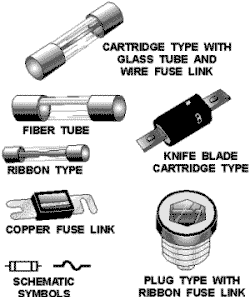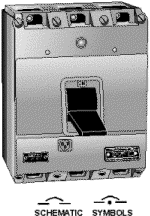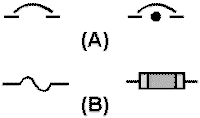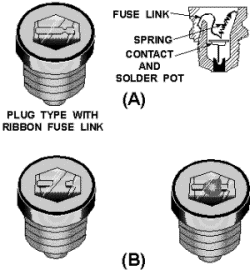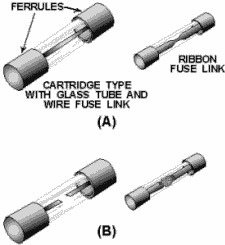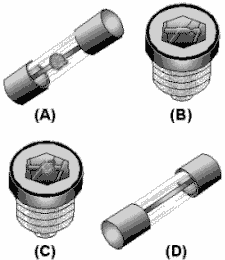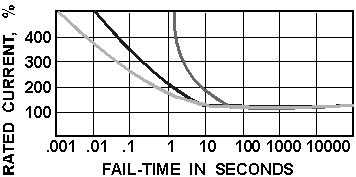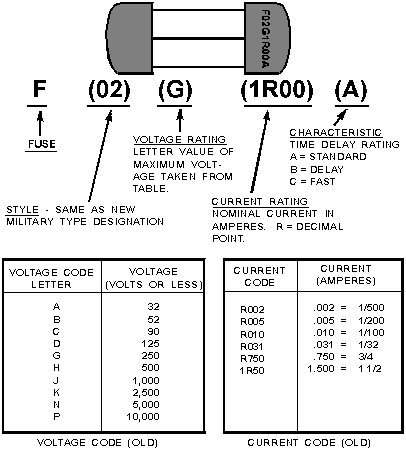Module 3 - Introduction to Circuit Protection, Control, and Measurement |
||||||||||||||||||||||||||||||||||||||||||||||||||
|
Module 3 −− Introduction to Circuit Protection, Control, and Measurement
Pages i, 1−1, 1−11, 1−21, 1−31, 1−41, 1−51, 1−61, 1−71, 2−1, 2−11, 1−21, 2−31, 2−41, 3−1, 3−11, 3−21, 3−31, AI−1, AII−1, AIII−1, IV−1, Index
Chapter 2
Circuit PROTECTION DEVICES Learning Objectives Upon completion of this chapter you will be able to: 1. State the reasons circuit protection is needed and three conditions requiring circuit protection. 2. Define a direct short, an excessive current condition, and an excessive heat condition. 3. State the way in which circuit protection devices are connected in a circuit. 4. Identify two types of circuit protection devices and label the schematic symbols for each type. 5. Identify a plug-type and a cartridge-type fuse (open and not open) from illustrations. 6. List the three characteristics by which fuses are rated and state the meaning of each rating. Identify a plug-type and a cartridge-type fuse (open and not open) from illustrations. 7. List the three categories of time delay rating for fuses and state a use for each type of time-delay rated fuse. 8. List the three categories of time delay rating for fuses and state a use for each type of time-delay rated fuse. Identify fuses as to voltage, current, and time delay ratings using fuses marked with the old military, new military, old commercial, and new commercial systems. List the three categories of time delay rating for fuses and state a use for each type of time-delay rated fuse. 9. Identify a clip-type and a post-type fuse holder from illustrations and identify the connections used on a post-type fuse holder for power source and load connections. 10. List the methods of checking for an open fuse, the items to check when replacing a fuse, the safety precautions to be observed when checking and replacing fuses, and the conditions to be checked for when conducting preventive maintenance on fuses. 11. Select a proper replacement and substitute fuse from a listing of fuses. 12. List the five main components of a circuit breaker and the three types of circuit breaker trip elements. 13. Describe the way in which each type of trip element reacts to excessive current. 14. Define the circuit breaker terms trip-free and nontrip-free and state one example for the use of each of these types of circuit breakers. 15. List the three time delay ratings of circuit breakers. 16. Define selective tripping, state why it is used, and state the way in which the time delay ratings of circuit breakers are used to design a selective tripping system. 17. Identify the factors used in selecting circuit breakers. 2-1 18. List the steps to follow before starting work on a circuit breaker and the items to be checked when maintaining circuit breakers. Circuit PROTECTION DEVICES Electricity, like fire, can be either helpful or harmful to those who use it. a fire can keep people warm and comfortable when it is confined in a campfire or a furnace. It can be dangerous and destructive if it is on the loose and uncontrolled in the woods or in a building. Electricity can provide people with the light to read by or, in a blinding flash, destroy their eyesight. It can help save people's lives, or it can kill them. While we take advantage of the tremendous benefits electricity can provide, we must be careful to protect the people and systems that use it. It is necessary then, that the mighty force of electricity be kept under control at all times. If for some reason it should get out of control, there must be a method of protecting people and equipment. Devices have been developed to protect people and electrical circuits from currents and voltages outside their normal operating ranges. Some examples of these devices are discussed in this chapter. While you study this chapter, it should be kept in mind that a circuit protection device is used to keep an undesirably large current, voltage, or power surge out of a given part of an electrical circuit.
Introduction
An electrical unit is built with great care to ensure that each separate electrical circuit is fully insulated from all the others. This is done so that the current in a circuit will follow its intended path. Once the unit is placed into service, however, many things can happen to alter the original circuitry. Some of the changes can cause serious problems if they are not detected and corrected. While circuit protection devices cannot correct an abnormal current condition, they can indicate that an abnormal condition exists and protect personnel and circuits from that condition. In this chapter, you will learn what circuit conditions require protection devices and the types of protection devices used.
Circuit CONDITIONS REQUIRING PROTECTION DEVICES
As has been mentioned, many things can happen to electrical and electronic circuits after they are in use. Chapter 1 of this module contains information showing you how to measure circuit characteristics to help determine the changes that can occur in them. Some of the changes in circuits can cause conditions that are dangerous to the circuit itself or to people living or working near the circuits. These potentially dangerous conditions require circuit protection. The conditions that require circuit protection are direct shorts, excessive current, and excessive heat.
Direct Short One of the most serious troubles that can occur in a circuit is a Direct Short. Another term used to describe this condition is a Short Circuit. The two terms mean the same thing and, in this chapter, the term direct short will be used. This term is used to describe a situation in which some point in the circuit, where full system voltage is present, comes in direct contact with the ground or return side of the circuit. This establishes a path for current flow that contains only the very small resistance present in the wires carrying the current. According to Ohm's law, if the resistance in a circuit is extremely small, the current will be extremely large. Therefore, when a direct short occurs, there will be a very large current through the wires. Suppose, for instance, that the two leads from a battery to a motor came in contact with each other. If the leads were bare at the point of contact, there would be a direct short. The motor would stop running
2-2 because all the current would be flowing through the short and none through the motor. The battery would become discharged quickly (perhaps ruined) and there could be the danger of fire or explosion. The battery cables in our example would be large wires capable of carrying heavy currents. Most wires used in electrical circuits are smaller and their current carrying capacity is limited. The size of wire used in any given circuit is determined by space considerations, cost factors, and the amount of current the wire is expected to carry under normal operating conditions. Any current flow greatly in excess of normal, such as there would be in the case of a direct short, would cause a rapid generation of heat in the wire. If the excessive current flow caused by the direct short is left unchecked, the heat in the wire will continue to increase until some portion of the circuit burns. Perhaps a portion of the wire will melt and open the circuit so that nothing is damaged other than the wire involved. The probability exists, however, that much greater damage will result. The heat in the wire can char and burn the insulation of the wire and that of other wires bundled with it, which can cause more shorts. If a fuel or oil leak is near any of the hot wires, a disastrous fire might be started.
Excessive Current It is possible for the circuit current to increase without a direct short. If a resistor, capacitor, or inductor changes value, the total circuit impedance will also change in value. If a resistor decreases in ohmic value, the total circuit resistance decreases. If a capacitor has a dielectric leakage, the capacitive reactance decreases. If an inductor has a partial short of its winding, inductive reactance decreases. Any of these conditions will cause an increase in circuit current. Since the circuit wiring and components are designed to withstand normal circuit current, an increase in current would cause overheating (just as in the case of a direct short). Therefore, excessive current without a direct short will cause the same problems as a direct short.
Excessive Heat As you have read, most of the problems associated with a direct short or excessive current concern the heat generated by the higher current. The damage to circuit components, the possibility of fire, and the possibility of hazardous fumes being given off from electrical components are consequences of excessive heat. It is possible for excessive heat to occur without a direct short or excessive current. If the bearings on a motor or generator were to fail, the motor or generator would overheat. If the temperature around an electrical or electronic circuit were to rise (through failure of a cooling system for example), excessive heat would be a problem. No matter what the cause, if excessive heat is present in a circuit, the possibility of damage, fire, and hazardous fumes exists.
Q1. Why are circuit protection devices necessary?
Q2. What are the three conditions that require circuit protection?
Q3. What is a direct short?
Q4. What is an excessive current condition?
Q5. What is an excessive heat condition? Circuit PROTECTION DEVICES All of the conditions mentioned are potentially dangerous and require the use of circuit protection devices. Circuit protection devices are used to stop current flow or open the circuit. To do this, a circuit protection device must ALWAYS be connected in series with the circuit it is protecting. If the protection 2-3 device is connected in parallel, current will simply flow around the protection device and continue in the circuit. A circuit protection device operates by opening and interrupting current to the circuit. The opening of a protection device shows that something is wrong in the circuit and should be corrected before the current is restored. When a problem exists and the protection device opens, the device should isolate the faulty circuit from the other unaffected circuits, and should respond in time to protect unaffected components in the faulty circuit. The protection device should NOT open during normal circuit operation. The two types of circuit protection devices discussed in this chapter are fuses and circuit breakers.
Fuses A fuse is the simplest circuit protection device. It derives its name from the Latin word "fusus," meaning "to melt." Fuses have been used almost from the beginning of the use of electricity. The earliest type of fuse was simply a bare wire between two connections. The wire was smaller than the conductor it was protecting and, therefore, would melt before the conductor it was protecting was harmed. Some "copper fuse link" types are still in use, but most fuses no longer use copper as the fuse element (the part of the fuse that melts). After changing from copper to other metals, tubes or enclosures were developed to hold the melting metal. The enclosed fuse made possible the addition of filler material, which helps to contain the arc that occurs when the element melts. For many low power uses, the finer material is not required. a simple glass tube is used. The use of a glass tube gives the added advantage of being able to see when a fuse is open. Fuses of this type are commonly found in automobile lighting circuits. Figure 2-1 shows several fuses and the symbols used on schematics.
Figure 2-1. - Typical fuses and schematic symbols. 2-4 Circuit Breakers While a fuse protects a circuit, it is destroyed in the process of opening the circuit. Once the problem that caused the increased current or heat is corrected, a new fuse must be placed in the circuit. a circuit protection device that can be used more than once solves the problems of replacement fuses. Such a device is safe, reliable, and tamper proof. It is also resettable, so it can be reused without replacing any parts. This device is called a Circuit BREAKER because it breaks (opens) the circuit. The first compact, workable circuit breaker was developed in 1923. It took 4 years to design a device that would interrupt circuits of 5000 amperes at 120 volts ac or dc. In 1928 the first circuit breaker was placed on the market. a typical circuit breaker and the appropriate schematic symbols are shown in figure 2-2.
Figure 2-2. - Typical circuit breaker and schematic symbols.
Q6. How are circuit protection devices connected to the circuit they are intended to protect and why are they connected in this way?
Q7. What are the two types of circuit protection devices?
Q8. Label the schematic symbols shown in figure 2-3 below.
Figure 2-3. - Schematic symbols. 22-5 FUSE TYPES Fuses are manufactured in many shapes and sizes. In addition to the copper fuse link already described, figure 2-1 shows other fuse types. While the variety of fuses may seem confusing, there are basically only two types of fuses: plug-type fuses and cartridge fuses. Both types of fuses use either a single wire or a ribbon as the fuse element (the part of the fuse that melts). The condition (good or bad) of some fuses can be determined by visual inspection. The condition of other fuses can only be determined with a meter. In the following discussion, visual inspection will be described. The use of meters to check fuses will be discussed later in this chapter.
PLUG-TYPE FUSE
The plug-type fuse is constructed so that it can be screwed into a socket mounted on a control panel or electrical distribution center. The fuse link is enclosed in an insulated housing of porcelain or glass. The construction is arranged so the fuse link is visible through a window of mica or glass. Figure 2-4 shows a typical plug-type fuse.
Figure 2-4. - Plug-type fuses
Figure 2-4, view A, sows a good plug-type fuse. Notice the construction and the fuse link. In figure 2-4, view B, the same type of fuse is shown after the fuse link has melted. Notice the window showing the indication of this open fuse. The indication could be either of the ones shown in figure 2-4, view B. The plug-type fuse is used primarily in low-voltage, low-current circuits. The operating range is usually up to 150 volts and from 0.5 ampere to 30 amperes. This type of fuse is found in older circuit protection devices and is rapidly being replaced by the circuit breaker.
CARTRIDGE FUSE
The cartridge fuse operates exactly like the plug-type fuse. In the cartridge fuse, the fuse link is enclosed in a tube of insulating material with metal ferrules at each end (for contact with the fuse holder). Some common insulating materials are glass, bakelite, or a fiber tube filled with insulating powder. 2-6 Figure 2-5 shows a glass-tube fuse. In figure 2-5, view A, notice the fuse link and the metal ferrules. Figure 2-5, view B, shows a glass-tube fuse that is open. The open fuse link could appear either of the ways shown in figure 2-5, view B.
Figure 2-5. - Cartridge-tube fuse.
Cartridge fuses are available in a variety of physical sizes and are used in many different circuit applications. They can be rated at voltages up to 10,000 volts and have current ratings of from 1/500 (.002) ampere to 800 amperes. Cartridge fuses may also be used to protect against excessive heat and open at temperatures of from 165° F to 410°F (74°C to 210°C). Q9. Label the fuses shown in figure 2-6 according to type.
Q10. Identify the open fuses shown in figure 2-6.
Figure 2-6. - Fuse recognition. 2-7 FUSE RATINGS
You can determine the physical size and type of a fuse by looking at it, but you must know other things about a fuse to use it properly. Fuses are rated by current, voltage, and time-delay characteristics to aid in the proper use of the fuse. To select the proper fuse, you must understand the meaning of each of the fuse ratings.
CURRENT RATING
The current rating of a fuse is a value expressed in amperes that represents the current the fuse will allow without opening. The current rating of a fuse is always indicated on the fuse. To select the proper fuse, you must know the normal operating current of the circuit. If you wish to protect the circuit from overloads (excessive current), select a fuse rated at 125 percent of the normal circuit current. In other words, if a circuit has a normal current of 10 amperes, a 12.5-ampere fuse will provide overload protection. If you wish to protect against direct shorts only, select a fuse rated at 150 percent of the normal circuit current. In the case of a circuit with 10 amperes of current, a 15 ampere fuse will protect against direct shorts, but will not be adequate protection against excessive current.
Voltage RATING
The voltage rating of a fuse is NOT an indication of the voltage the fuse is designed to withstand while carrying current. The voltage rating indicates the ability of the fuse to quickly extinguish the arc after the fuse element melts and the maximum voltage the open fuse will block. In other words, once the fuse has opened, any voltage less than the voltage rating of the fuse will not be able to "jump" the gap of the fuse. Because of the way the voltage rating is used, it is a maximum rms voltage value. You must always select a fuse with a voltage rating equal to or higher than the voltage in the circuit you wish to protect.
TIME DELAY RATING
There are many kinds of electrical and electronic circuits that require protection. In some of these circuits, it is important to protect against temporary or transient current increases. Sometimes the device being protected is very sensitive to current and cannot withstand an increase in current. In these cases, a fuse must open very quickly if the current increases. Some other circuits and devices have a large current for short periods and a normal (smaller) current most of the time. An electric motor, for instance, will draw a large current when the motor starts, but normal operating current for the motor will be much smaller. a fuse used to protect a motor would have to allow for this large temporary current, but would open if the large current were to continue. Fuses are time delay rated to indicate the relationship between the current through the fuse and the time it takes for the fuse to open. The three time delay ratings are delay, standard, and fast.
Delay A delay, or slow-blowing, fuse has a built-in delay that is activated when the current through the fuse is greater than the current rating of the fuse. This fuse will allow temporary increases in current (surge) without opening. Some delay fuses have two elements; this allows a very long time delay. If the over- current condition continues, a delay fuse will open, but it will take longer to open than a standard or a fast fuse. Delay fuses are used for circuits with high surge or starting currents, such as motors, solenoids, and transformers. 2-8 Standard Standard fuses have no built-in time delay. Also, they are not designed to be very fast acting. Standard fuses are sometimes used to protect against direct shorts only. They may be wired in series with a delay fuse to provide faster direct short protection. For example, in a circuit with a 1-ampere delay fuse, a 5-ampere standard fuse may be used in addition to the delay fuse to provide faster protection against a direct short. A standard fuse can be used in any circuit where surge currents are not expected and a very fast opening of the fuse is not needed. a standard fuse opens faster than a delay fuse, but slower than a fast rated fuse.
Fast Standard fuses can be used for automobiles, lighting circuits, or electrical power circuits. Fast fuses are designed to open very quickly when the current through the fuse exceeds the current rating of the fuse. Fast fuses are used to protect devices that are very sensitive to increased current. a fast fuse will open faster than a delay or standard fuse. Fast fuses can be used to protect delicate instruments or semiconductor devices. Figure 2-7 will help you understand the differences between delay, standard, and fast fuses. Figure 2-7 shows that, if a 1-ampere rated fuse had 2 amperes of current through it, (200% of the rated value), a fast fuse would open in about .7 second, a standard rated fuse would open in about 1.5 seconds, and a delay rated fuse would open in about 10 seconds. Notice that in each of the fuses, the time required to open the fuse decreases as the rated current increases.
Figure 2-7. - Time required for fuse to open.
Q11. In what three ways are fuses rated?
Q12. What does the current rating of a fuse indicate?
Q13. What does the voltage rating of a fuse indicate?
Q14. What are the three time delay ratings of fuses?
Q15. Give an example of a device you could protect with each type of time delay fuse. 2-9 IDENTIFICATION of FUses
Fuses have identifications printed on them. The printing on the fuse will identify the physical size, the type of fuse, and the fuse ratings. There are four different systems used to identify fuses. The systems are the old military designation, the new military designation, the old commercial designation, and the new commercial designation. All four systems are presented here, so you will be able to identify a fuse no matter which designation is printed on the fuse. You may have to replace an open fuse that is identified by one system with a good fuse that is identified by another system. The designation systems are fairly simple to understand and cross-reference once you are familiar with them.
OLD MILITARY DESIGNATION
Figure 2-8 shows a fuse with the old military designation. The tables in the lower part of the figure show the voltage and current codes used in this system. The upper portion of the figure is the explanation of the old military designation. The numbers and letters in parentheses are the coding for the fuse shown in figure 2-8.
Figure 2-8. - Old type military fuse designation.
The old military designation always starts with "F," which stands for fuse. Next, the set of numbers (02) indicates the style. Style means the construction and dimensions (size) of the fuse. Following the style is a letter that represents the voltage rating of the fuse (G). The voltage code table in figure 2-8 shows each voltage rating letter and its meaning in volts. In the example shown, the voltage ratings is G, 2-10
|
||||||||||||||||||||||||||||||||||||||||||||||||||
